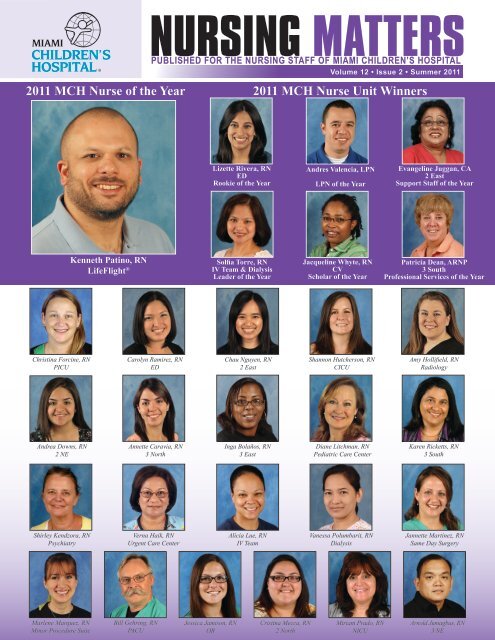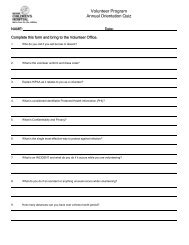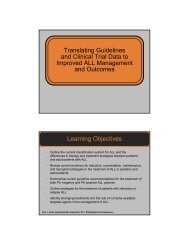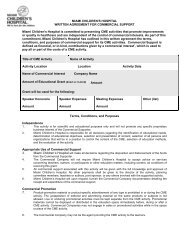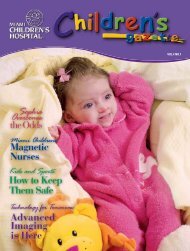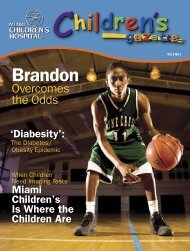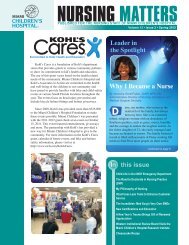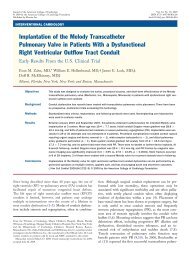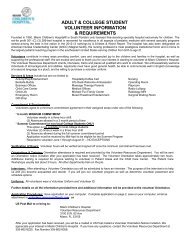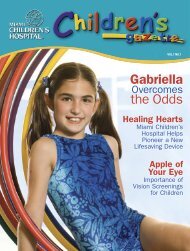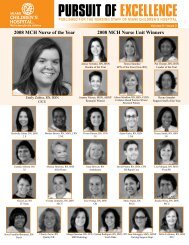NURSING MATTERS - Miami Children's Hospital
NURSING MATTERS - Miami Children's Hospital
NURSING MATTERS - Miami Children's Hospital
Create successful ePaper yourself
Turn your PDF publications into a flip-book with our unique Google optimized e-Paper software.
<strong>NURSING</strong> <strong>MATTERS</strong>PUBLISHED FOR THE <strong>NURSING</strong> STAFF OF MIAMI CHILDREN’S HOSPITALVolume 12 • Issue 2 • Summer 20112011 MCH Nurse of the Year2011 MCH Nurse Unit WinnersLizette Rivera, RNEDRookie of the YearAndres Valencia, LPNLPN of the YearEvangeline Juggan, CA2 EastSupport Staff of the YearKenneth Patino, RNLifeFlight ®Solfia Torre, RNIV Team & DialysisLeader of the YearJacqueline Whyte, RNCVScholar of the YearPatricia Dean, ARNP3 SouthProfessional Services of the YearChristina Forcine, RNPICUCarolyn Ramirez, RNEDChau Nguyen, RN2 EastShannon Hutcherson, RNCICUAmy Hollifield, RNRadiologyAndrea Downs, RN2 NEAnnette Caravia, RN3 NorthInga Bolaños, RN3 EastDiane Litchman, RNPediatric Care CenterKaren Ricketts, RN3 SouthShirley Kendzora, RNPsychiatryVerna Haik, RNUrgent Care CenterAlicia Lue, RNIV TeamVanessa Polumbarit, RNDialysisJannette Martinez, RNSame Day SurgeryMarlene Marquez, RNMinor Procedure SuiteBill Gehring, RNPACUJessica Jamison, RNORCristina Mecca, RN2 NorthMiriam Prado, RNNICUArnold Jumagbas, RN3 NE
NICU Nurses Save the WhalesBy Jane Larew, RN, NICUIn late May, several pilot whales were stranded at low tideon the shores of Cudjo Key. Although some of themperished, those that were healthy enough to be on theirown were released into the deep waters of the Atlantic Ocean.Those that were not healthy were transferred to the MarineMammal Conservancy, located in Key Largo, for medical care andrehabilitation after their ALTE (acute life threatening event). Asair breathing mammals accustomed to inhabiting deep waters,their respiratory systems are not capable of handling the pressuresexerted by their own weight when stranded on dry land. Asthe tides rose, they were too weak to maneuver themselves off thebeach and salt water and debris was able to enter theirthe words are familiar,the techniquesand skills of the vetsand trainers differedtremendously fromthose with whichwe are accustomed.They pass NGTs(the size of a gardenhose) through rowsof razor sharp teethto hydrate and feed the smallest and sickestof the whales.Nothing about the pilot whale’s care is routine. They are wild creaturesin distress being held and touched by different humans everyfour-hour shift. We are a species they had never encountered beforeand must seem so alien to them, but they are smart and quickto trust. Some of us have returned to volunteer many times and wesee the progress of some but are saddened by the loss of those whowere unable to overcome the severe trauma of beaching.Life is fragile on our planet, for us, our families and the childrenfor whom we provide care. There are few certainties in this life.I have felt a deep appreciation for life and, along with the othernurses from NICU, I am touched by our experience with thesemagnificent creatures.blowholes, causing them to aspirate. They arrived at the“hospital” for treatment and the Marine Mammal Conservancyvolunteer group began the arduous task of holding the whales sothat they could breathe. The call went out for more volunteers,as each whale required three to four humans to create whatamounted to floating hospital beds, and each whale had to be heldaround the clock. Without the human hands, the whales wouldsink and aspirate more salt water through their blowholes and intotheir lungs, only worsening their pneumonia.The pilot whales that were released are being tracked and are veryactive in deep water once again.The nursing staff in the NICU responded to the call. Megan, ourClinical Coordinator, organized a “field trip” for us. A time was setfor 4 a.m. to 8 a.m. to go to Key Largo and lend a helping hand.Although not all of the volunteers were able to attend, those whodid go had a once- in-a-lifetime experience.What does it feel like to hold an 800-pound baby whale or a1,200-pound toddler whale, count its heartbeat and respirationsand hold it afloat for four hours at a time? Aside from the weightdifference of course, it is remarkably similar to the “touch times”we do in the NICU. Checking heart rate, respirations, giving aerosols,monitoring thermoregulation, providing nutritional feedings,administering meds, aiding with physical therapy to encouragenormal movement and ROM as well as drawing labs. Even though3
Therapeutic Hypothermia for Cardiac Surgeryat MCH CV ServicePostoperative Re-warming after Cardiac SurgeryBy David Aguero, CV OR RNIn our pediatric heart surgery service, therapeutichypothermia is utilized during cardiac surgery toprotect the vital organs of patients duringcardiopulmonary bypass. Depending upon thecomplexity of the procedure – which could be ascomplex as a Norwood procedure or as simple as anatrial septal defect repair – the patient’s bodytemperature is decreased. The decrease might range from28 degrees Celsius for a simple procedure to 17 degreesCelsius for a more complex procedure. The lowertemperature prevents damage to vital organs and tissues.During the procedure, organs are continuouslymonitored, especially the brain, through use of a headoximeter probes (somanetics). The perfusion team alsoobtains blood gases at regular intervals to check allcritical levels especially PO2, CO2, K, Ca, glucose andmore. It has been proven over more than 15 years thattherapeutic hypothermia has benefited many of thepediatric heart surgery patients in our cardiac service.Our MCH cardiovascular surgery team uses airwarmers, water heater pads and IV fluid warmers tore-warm the patients after cardiac surgery. The warmprotocol is to keep the patient covered with warm blanketsupon transfer to CICU to maintain the patient’s optimumtemperature post operatively. Depending on thecomplexity of the case and the severity of patient diagnosis,the aim is to keep a body temperature above 34Cº-35Cº toprevent cardiac arrhythmias or other complications postoperatively. Efficacy of postoperative re-warming andmaintenance of normal temperature is a team effort thatbegins in the OR and continues in postoperative care forsuccessful recovery of patients.Nursing Matters isproduced quarterly byand for the nursing staff of<strong>Miami</strong> Children’s <strong>Hospital</strong>in collaboration with theMarketing departmentJackie Gonzalez, ARNP,MSN, NEA-BC, FAANSenior Vice President,Chief Nursing Officer,Patient Safety OfficerMarcia Diaz de VillegasDirector of Marketing andPublic RelationsMarketing Editor:Rachel PerryNursing editors:Joy Ortiz, RN, CCRNMonica Brown, RN, MSN,CPNContributing Writers:The nursing staff of<strong>Miami</strong> Children’s<strong>Hospital</strong>Layout: Roberto PerezPhotography:Edgar Estrada,Steven Llanes,Juan Carlos Rabionet1701-RDP072011


